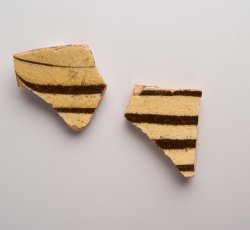Unid: Tableware - Page 2 of 3


Red-bodied, black glazed holloware vessel.
Coarse Earthenware | Object #: 1722186
Mottled glaze. Wall curvature similar to mug/can.
Explore This Item
Staffordshire slipware trailed dish or plate.
Coarse Earthenware | Object #: 1722281
This fragment is a ceramic archaeologists refer to as North Midlands/Staffordshire type slipware. The word “type” is used here to denote the fact that coarse, slip decorated wares were actually produced in several regions of England throughout the seventeenth and eighteenth century. One feature...
Explore This Item
Staffordshire slipware trailed and combed dish or plate.
Coarse Earthenware | Object #: 1722283
This fragment is a ceramic archaeologists refer to as North Midlands/Staffordshire type slipware. The word “type” is used here to denote the fact that coarse, slip decorated wares were actually produced in several regions of England throughout the seventeenth and eighteenth century. One feature...
Explore This Item
Staffordshire slipware trailed and combed dish or plate.
Coarse Earthenware | Object #: 1722392
This fragment is a ceramic archaeologists refer to as North Midlands/Staffordshire type slipware. The word “type” is used here to denote the fact that coarse, slip decorated wares were actually produced in several regions of England throughout the seventeenth and eighteenth century. One feature...
Explore This Item
Staffordshire slipware trailed and combed dish or plate.
Coarse Earthenware | Object #: 1722407
This fragment is a ceramic archaeologists refer to as North Midlands/Staffordshire type slipware. The word “type” is used here to denote the fact that coarse, slip decorated wares were actually produced in several regions of England throughout the seventeenth and eighteenth century. One feature...
Explore This Item
Staffordshire slipware marbled dish or plate.
Coarse Earthenware | Object #: 1722414
This fragment is a ceramic archaeologists refer to as North Midlands/Staffordshire type slipware. The word “type” is used here to denote the fact that coarse, slip decorated wares were actually produced in several regions of England throughout the seventeenth and eighteenth century. One feature...
Explore This Item
Staffordshire slipware marbled dish or plate with pie crust rim.
Coarse Earthenware | Object #: 1722430
This fragment is a ceramic archaeologists refer to as North Midlands/Staffordshire type slipware. The word “type” is used here to denote the fact that coarse, slip decorated wares were actually produced in several regions of England throughout the seventeenth and eighteenth century. One feature...
Explore This Item
Staffordshire slipware flatware.
Coarse Earthenware | Object #: 1722436
This fragment is a ceramic archaeologists refer to as North Midlands/Staffordshire type slipware. The word “type” is used here to denote the fact that coarse, slip decorated wares were actually produced in several regions of England throughout the seventeenth and eighteenth century. One feature...
Explore This Item
Staffordshire slipware marbled dish or plate.
Coarse Earthenware | Object #: 1722437
This fragment is a ceramic archaeologists refer to as North Midlands/Staffordshire type slipware. The word “type” is used here to denote the fact that coarse, slip decorated wares were actually produced in several regions of England throughout the seventeenth and eighteenth century. One feature...
Explore This Item
Staffordshire slipware dotted cup or drinking pot.
Coarse Earthenware | Object #: 1722451
This fragment is a ceramic archaeologists refer to as North Midlands/Staffordshire type slipware. The word “type” is used here to denote the fact that coarse, slip decorated wares were actually produced in several regions of England throughout the seventeenth and eighteenth century. One feature...
Explore This Item
Manganese mottled holloware with cordons.
Coarse Earthenware | Object #: 1722493
This is a sherd of an unidentified hollow tableware vessel, made of a coarse earthenware which archaeologists refer to as Staffordshire mottled or manganese mottled. The paste of this ceramic type is often tan or buff with few, if any, inclusions, though larger and thicker vessels can have a mi...
Explore This Item
Manganese mottled holloware.
Coarse Earthenware | Object #: 1722496
This is a sherd of an unidentified hollow tableware vessel, made of a coarse earthenware which archaeologists refer to as Staffordshire mottled or manganese mottled. The paste of this ceramic type is often tan or buff with few, if any, inclusions, though larger and thicker vessels can have a mi...
Explore This Item
Handpainted polychrome tin-glazed earthenware dish or plate.
Refined Earthenware | Object #: 1722589
This is fragment of a tin-glazed earthenware dish or plate. This ware is often referred to by archaeologists as delftware. Ceramics such as these were produced in numerous locations in both Britain and Holland beginning in the seventeenth-century, though production continued through the end of ...
Explore This Item
Handpainted blue tin-glaze earthenware plate or dish.
Refined Earthenware | Object #: 1722601
This is a fragment of a tin-glazed earthenware dish or plate. This ware is often referred to by archaeologists as delftware. The white coloration of the glaze was obtained by adding tin-oxide to a lead glaze. Against this white field, delft was most often decorated with hand painted cobalt blue...
Explore This Item
Handpainted blue tin-glaze earthenware plate or dish.
Refined Earthenware | Object #: 1722700
This is a fragment of a tin-glazed earthenware dish or plate. This ware is often referred to by archaeologists as delftware. The white coloration of the glaze was obtained by adding tin-oxide to a lead glaze. Against this white field, delft was most often decorated with hand painted cobalt blue...
Explore This Item
Handpainted blue tin-glaze earthenware plate or dish.
Refined Earthenware | Object #: 1722710
This is a fragment encompassing the marly, body and base of a tin-glazed earthenware dish or plate. This ware is often referred to by archaeologists as delftware. The white coloration of the glaze was obtained by adding tin-oxide to a lead glaze. Against this white field, delft was most often d...
Explore This Item
Handpainted blue tin-glaze earthenware tableware.
Refined Earthenware | Object #: 1722729
This is a body fragment of a tin-glazed earthenware unidentified tableware. This ware is often referred to by archaeologists as delftware. The white coloration of the glaze was obtained by adding tin-oxide to a lead glaze. Against this white field, delft was most often decorated with hand paint...
Explore This Item
Handpainted blue tin-glaze earthenware plate or dish.
Refined Earthenware | Object #: 1722839
Very similar decoration to object 1722710.
Explore This Item
Feather-edge creamware plate or dish.
Refined Earthenware | Object #: 1723101
This fragment of cream colored ceramic is a portion of a plate or platter decorated with a feather edged pattern along the rim. Archaeologists refer to this kind of ceramic as creamware and associate it with that produced by English potter Josiah Wedgewood beginning in 1762. Wedgewood successfu...
Explore This Item